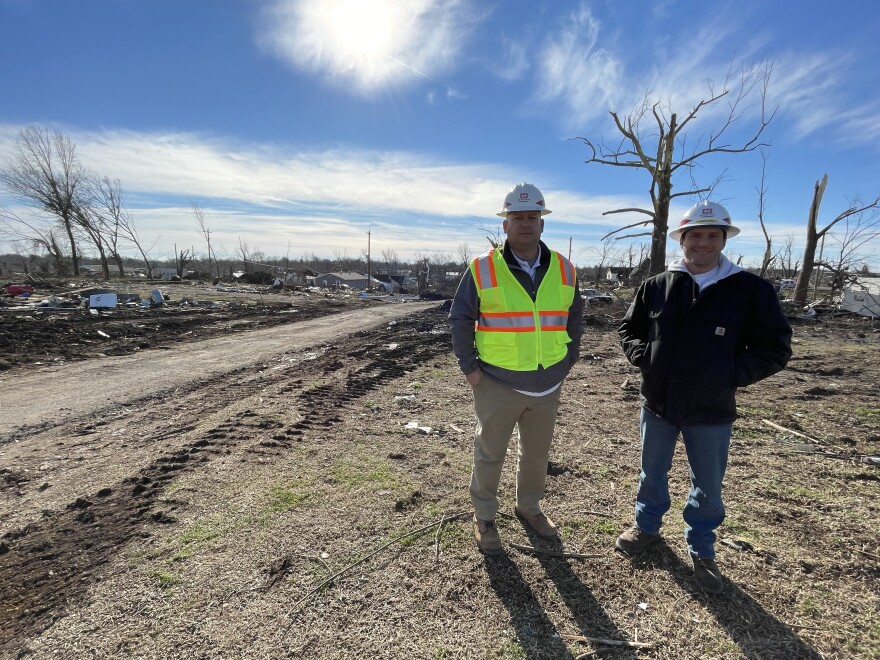A large dumpster truck rolls down what used to be a residential street on a clear January day in Mayfield, stopping near the rubble of where a home once was. A white door, window frames and broken pieces of wood lie scattered across the ground.
Yet on the back of this truck, a man operates what looks like a big toy crane, swinging it over to the debris, scooping it up and dumping it into the truck. It’s specialized equipment like this that is chipping away at the cleanup in Graves County, which was devastated by an EF4 tornado that tore through the heart of the historic downtown in December.
It’ll be a long process. George Minges, Emergency Management Chief with the U.S. Army Corps of Engineers (USACE) Louisville District, said the EF5 tornado that hit Joplin, Missouri, in 2011 created about 1.5 million cubic yards of debris. It’s a memorable disaster that brings up the term “clean slate” in the minds of those in the federal government, he said, referring to the homes wiped completely away in that community.
Minges, who’s coordinating this massive cleanup, said some areas of Mayfield could have a similar “clean slate” look when the agency is expected to be done with its mission by the end of April.
“Some people have written on the sides their houses, ‘don't demolish, please save, don't bulldoze.’ So those may still be standing,” Minges said. “It’d almost kind of be islands out there in these cleared areas.”

The tornado that hit Graves County is estimated to have created 2 million cubic yards of debris. That could fill the entire inside of the 102-story Empire State Building and fill it again halfway.
The moving pieces of this effort are enormous. About 60 trucks and other hauling units are moving around the small city picking up debris, and the city has been split up into four zones to coordinate efforts. In many cases, the workers operating the trucks, excavators and other equipment are often the people and families directly impacted by the storm.
Derrian Carruthers is following along the dumpster truck with the crane, marking down the location of where debris is picked up and what type of debris. He lives in Paducah and has family in Mayfield. When the tornado came through, he took a truck into town to make sure his family and grandmother were safe and had supplies.
“It’s sad,” Carruthers said. “People lost everything. Their homes. People don’t have nowhere to go.”
He’s glad himself and others are employed to help clean up their city and have an income to get back on their feet, given that many lost jobs after a local candle factory and chicken hatchery were demolished by the disaster.
Texas-based DRC Emergency Services is the contractor USACE hired to coordinate companies and individuals working the clean-up. They did not respond to requests for an interview. Minges said both DRC Emergency Services and USACE are in charge of keeping workers safe, following USACE safety manuals that are “typically more stringent” than protocols from the Occupational Health and Safety Administration.
Following such a large natural disaster, many kinds of debris are being sorted through, Minges said, and what kind of debris is picked up helps determine where it ultimately ends up and how it is disposed of.
Vegetative debris – trees, branches, sticks – is taken to a local landfill just outside of town to be incinerated. Construction and demolition debris – things like drywall, wood and carpet from damaged homes – is being put into a lined landfill that is “capped” to prevent it from contaminating the outside environment, a USACE spokesperson said. More hazardous material such as oil, paint and household cleaners are being taken to separate sites managed by the U.S. Environmental Protection Agency. Some material, like the metal from a collapsed 500,000-thousand gallon water tower, is looking to be recycled.

At the end of their runs, trucks hauling debris go to the local landfill, where a wooden lookout built next to the road looks inside the truck beds to check to see how full and empty the trucks are moving in and out of the landfill. This process also serves to confirm that the right kind of debris is being hauled in.
Yet for federal officials, this process isn’t just a logistical challenge. They’re helping a place they have an emotional connection with. USACE leaders have covered disasters in Louisiana, Tennessee and the Virgin Islands. Some leaders on the scene are native Kentuckians or transplants to Louisville, where the USACE district office is located.
Minges sees the debris and devastation as a visual, traumatic reminder of what happened to Graves County. If the agency can get the debris cleared, it can be a small step toward recovery and normalcy that may take years to ultimately reach.
“If we can get that debris out of here, if we can get into the streets cleaned back up, if we can get it to look anything like the old Mayfield, that's good for morale, it's good for the emotional state, it's good for the mental health of the people that had to live through this,” Minges said.
USACE has already gathered more than 155,000 cubic yards of debris as of Jan. 20 across the county so far, that’s enough to fill more than 45 Olympic-sized pools. That’s less than 8% of the total estimated removal operations, according to USACE.






